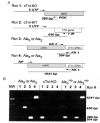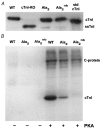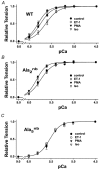Protein kinase C and A sites on troponin I regulate myofilament Ca2+ sensitivity and ATPase activity in the mouse myocardium
- PMID: 12923217
- PMCID: PMC2343448
- DOI: 10.1113/jphysiol.2003.045260
Protein kinase C and A sites on troponin I regulate myofilament Ca2+ sensitivity and ATPase activity in the mouse myocardium
Abstract
Cardiac troponin I (cTnI) is a phosphoprotein subunit of the troponin-tropomyosin complex that is thought to inhibit cardiac muscle contraction during diastole. To investigate the contributions of cTnI phosphorylation to cardiac regulation, transgenic mice were created with the phosphorylation sites of cTnI mutated to alanine. Activation of protein kinase C (PKC) by perfusion of hearts with phorbol-12-myristate-13-acetate (PMA) or endothelin-1 (ET-1) inhibited the maximum ATPase rate by up to 25 % and increased the Ca2+ sensitivity of ATPase activity and of isometric tension by up to 0.15 pCa units. PKC activation no longer altered cTnI phosphorylation, depressed ATPase rates or enhanced myofilament Ca2+ sensitivity in transgenic mice expressing cTnI that could not be phosphorylated on serines43/45 and threonine144 (PKC sites). Modest changes in myosin regulatory light chain phosphorylation occurred in all mouse lines, but increases in myofilament Ca2+ sensitivity required the presence of phosphorylatable cTnI. For comparison, the beta-adrenergic agonist isoproterenol caused a 38 % increase in maximum ATPase rate and a 0.12 pCa unit decrease in myofilament Ca2+ sensitivity. These beta-adrenergic effects were absent in transgenic mice expressing cTnI that could not be phosphorylated on serines23/24 (protein kinase A, PKA, sites). Overall, the results indicate that PKC and PKA exert opposing effects on actomyosin function by phosphorylating cTnI on distinct sites. A primary role of PKC phosphorylation of cTnI may be to reduce the requirements of the contractile apparatus for both Ca2+ and ATP, thereby promoting efficient ATP utilisation during contraction.
Figures






Similar articles
-
Troponin I modulation of cardiac performance: Plasticity in the survival switch.Arch Biochem Biophys. 2019 Mar 30;664:9-14. doi: 10.1016/j.abb.2019.01.025. Epub 2019 Jan 23. Arch Biochem Biophys. 2019. PMID: 30684464 Free PMC article. Review.
-
Phosphorylation of troponin I controls cardiac twitch dynamics: evidence from phosphorylation site mutants expressed on a troponin I-null background in mice.Circ Res. 2002 Apr 5;90(6):649-56. doi: 10.1161/01.res.0000014080.82861.5f. Circ Res. 2002. PMID: 11934831
-
PKC-betaII sensitizes cardiac myofilaments to Ca2+ by phosphorylating troponin I on threonine-144.J Mol Cell Cardiol. 2006 Nov;41(5):823-33. doi: 10.1016/j.yjmcc.2006.08.016. Epub 2006 Sep 29. J Mol Cell Cardiol. 2006. PMID: 17010989
-
Protein kinase D is a novel mediator of cardiac troponin I phosphorylation and regulates myofilament function.Circ Res. 2004 Nov 26;95(11):1091-9. doi: 10.1161/01.RES.0000149299.34793.3c. Epub 2004 Oct 28. Circ Res. 2004. PMID: 15514163
-
Regulation of cardiac contractile proteins. Correlations between physiology and biochemistry.Circ Res. 1984 Nov;55(5):565-74. doi: 10.1161/01.res.55.5.565. Circ Res. 1984. PMID: 6091939 Review.
Cited by
-
Protein kinase C depresses cardiac myocyte power output and attenuates myofilament responses induced by protein kinase A.J Muscle Res Cell Motil. 2012 Dec;33(6):439-48. doi: 10.1007/s10974-012-9294-9. Epub 2012 Apr 22. J Muscle Res Cell Motil. 2012. PMID: 22527640 Free PMC article.
-
Troponin I modulation of cardiac performance: Plasticity in the survival switch.Arch Biochem Biophys. 2019 Mar 30;664:9-14. doi: 10.1016/j.abb.2019.01.025. Epub 2019 Jan 23. Arch Biochem Biophys. 2019. PMID: 30684464 Free PMC article. Review.
-
Ablation of ventricular myosin regulatory light chain phosphorylation in mice causes cardiac dysfunction in situ and affects neighboring myofilament protein phosphorylation.J Biol Chem. 2009 Feb 20;284(8):5097-106. doi: 10.1074/jbc.M807414200. Epub 2008 Dec 23. J Biol Chem. 2009. PMID: 19106098 Free PMC article.
-
Myofibrillar remodeling in cardiac hypertrophy, heart failure and cardiomyopathies.Can J Cardiol. 2006 Sep;22(11):953-68. doi: 10.1016/s0828-282x(06)70315-4. Can J Cardiol. 2006. PMID: 16971981 Free PMC article. Review.
-
Post-translational modifications of myofilament proteins involved in length-dependent prolongation of relaxation in rabbit right ventricular myocardium.Arch Biochem Biophys. 2013 Jul 1;535(1):22-9. doi: 10.1016/j.abb.2012.10.005. Epub 2012 Oct 19. Arch Biochem Biophys. 2013. PMID: 23085150 Free PMC article.
References
-
- Adelstein RS, Klee CB. Purification and characterization of smooth muscle myosin light chain kinase. J Biol Chem. 1981;256:7501–7509. - PubMed
-
- Andersen GG, Qvigstad E, Schiander I, Aass H, Osnes JB, Skomedal T. Alpha(1)AR-induced positive inotropic response in heart is dependent on myosin light chain phosphorylation. Am J Physiol. 2002;283:H1471–1480. - PubMed
-
- Burkart EM, Sumandea MP, Kobayashi T, Nili M, Martin AF, Homsher E, Solaro RJ. Phosphorylation or glutamic acid substitution at protein kinase C sites on cardiac troponin I differentially depress myofilament tension and shortening velocity. J Biol Chem. 2003;278:11265–11272. - PubMed
-
- Cohen MV, Baines CP, Downey JM. Ischemic preconditioning: from adenosine receptor of KATP channel. Annu Rev Physiol. 2000;62:79–109. - PubMed
Publication types
MeSH terms
Substances
Grants and funding
LinkOut - more resources
Full Text Sources
Molecular Biology Databases
Research Materials
Miscellaneous

